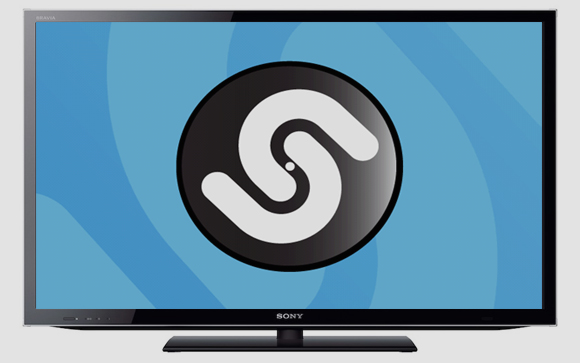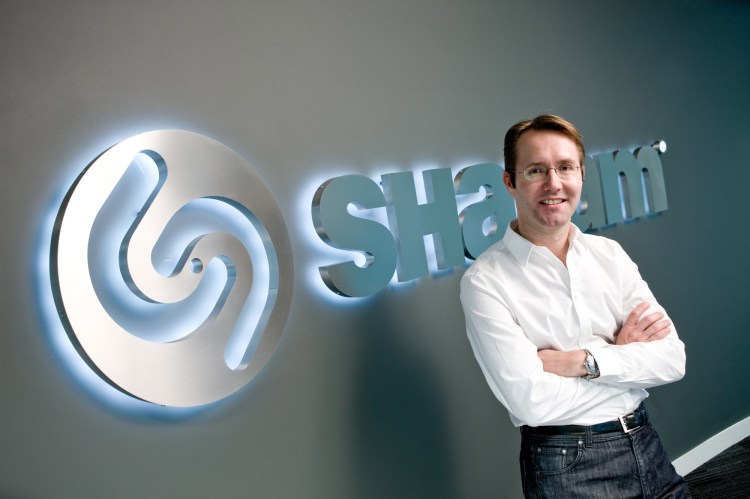
Naming that tune has been the name of Shazam’s game for more than decade. But should you confuse Shazam for a predictable, tired old company, you’re even more clueless than the perplexed person who can’t place a familiar track.
Founded in 2000, London-based Shazam is mostly recognized as the go-to mobile music application for song identification. It’s mobile applications have a following of 225 million people worldwide (90 million in the U.S.), who put it to use at least 10 million times per day.
Not content with owning the small but cozy category of mobile music discovery, Shazam has spent the past two-and-a-half years pushing forward with a strategy designed to remake the company as a modern-day media mogul. It’s recently taken to the television airways with Shazam-enable broadcasts and advertisements. But that is only the first part of a multifaceted Shazam media blitz that includes a move into retail and other sectors — in due time.
“We’ve got many ambitions and ideas about how we can make this more ubiquitous and be more helpful in people’s everyday lives,” Shazam CEO Andrew Fisher told VentureBeat in an extensive interview.
To fully grasp where the company is headed, one first has to understand its past.
The app that almost never was
Today’s mobile user takes for granted the complexity of Shazam’s audio fingerprinting technology. They also likely have no clue that it was developed when cellphones were quite stupid and investors in the U.S. were bewildered by mobile as platform.
The first inkling of the Shazam idea came from MBA students Chris Barton, Philip Inghelbrecht, and Dhiraj Mukherjee in 1999. The students took their idea to Dr. Avery Wang and Professor Julius Smith at Stanford, and the duo worked on building the algorithm. But the technology had to cross an ocean before it could find its legs.
“The reality at the time, when they were seeking their first initial funding, was that in North America the investor sentiment was very much focused on the Internet … whereas in Europe … mobile services were more established,” Fisher said, explaining why Shazam was eventually established in London. “People were much more taken with SMS.”
As a mobile proposition, Shazam was successful in terms of fundraising in London — while it hadn’t been successful in the States, he said.

Another obstacle facing the fledgling company, Fisher detailed, was that digital music had yet to develop into a category.
“ITunes didn’t exist at the time. People were only buying the very first iteration of ringtones … and even then that was still very early on in the lifecycle,” Fisher said. “There wasn’t significant interest in investing in music specifically as a mobile service, so the company was really forced to launch directly to consumers … and start educating people about Shazam.”
The company went forward with a direct-to-consumer offering in the U.K. in 2002. Consumers could dial the short code 2580 from their mobile phone, then hold the phone up to capture music playing in the background. Shazam would then analyze the track and send an SMS back with the song identification. Along with offers to sell the consumer a matching ringtone (everyone wanted ringtones back then), Shazam could begin to build a real business.
An inflection point
Shazam spent the next few years as a cool service for music discovery, but it would take a few more years before it could provide people with additional reasons to use Shazam, beyond just finding out the name of a song.
In 2003, company executives debated whether its technology was more valuable as a direct-response marketing tool or as a music-identification service. Music won out, but those early ideas were not forgotten, said Fisher.

Above: AT&T Music ID service, powered by Shazam
In the meantime, Shazam moved away from a direct-to-consumer approach to reach more people and monetize its service through relationships with carriers and manufacturers. The company formed strategic relationships with AT&T (MusicID) and Verizon (Song ID) and was working directly with handset manufacturers. Its apps were preloaded on many devices as a white label or cobranded service.
By 2007, markets had shifted in Shazam’s favor, enabling its first major reinvention.
As Fisher tells the story, four key factors came to together to enable the company to move beyond song identification.
- People starting becoming acclimated to the idea of buying digital content.
- The movement toward unlimited data — a single monthly fee that gave you all the bandwidth you could use.
- Meanwhile, better mobile devices with music players were hitting store shelves.
- And finally, prices for media on mobile platforms were finally on par with what consumers were used to paying for content in stores or online.
“That, in our minds, was an inflection point for the company,” said Fisher, citing the company’s capability to sell tracks on mobile directly to the consumers who were identifying songs.
But Shazam, the brand, was still one Apple-sized jolt away from real recognition.
The Apple bump
The word “Shazam” has been co-opted by the general population. Perhaps you’ve asked a friend, “What’s that song?” to which your friend responded, “I don’t know. Shazam it.”
Yet had Shazam stuck with its business-to-business, white label approach, the verb-ification of its name would have never happened.
Enter Apple.
On July 10, 2008, a little more than one year after the release of the first iPhone device and a day before the launch of the iPhone 3G, Apple put out version 2.0 of its iPhone software. Along with that release, Apple opened an application marketplace that included roughly 500 applications. One of those first applications was Shazam. Shazam had just 15 million users at the time.
The first native Shazam application for iPhone allowed people to discover, buy, and share music by holding their phones up to music for a few seconds. The technology worked similarly to its old SMS service but without the clunky limitations of text messaging.
“That’s when, for the first time in North America our brand, was really accelerated into the market,” Fisher said.
[youtube=http://www.youtube.com/watch?v=hny-G-0nUBM]
A few months later, Apple ran a television ad for the iPhone 3G that centered around Shazam. The ad changed everything.
“That had a huge impact in terms of awareness of the Shazam brand,” Fisher said. “That was the beginning of our recommitment to a fully fledged consumer strategy.”
By late September 2008, Shazam’s iPhone application had been downloaded 1.5 million times and its audience had climbed to 20 million people. Between October 2008 and October 2009, Shazam added another 30 million listeners.
The instant success of Shazam’s iPhone application was also an accidental one. The company, which had a prior relationship with Apple, had little clue that the hardware maker’s mobile software marketplace would be capable of building brands overnight — no one did, Fisher said. Shazam, asked by Apple to build a consumer-facing application, went along with the company’s plans. It merely hoped that it could benefit a bit from the PR activity surrounding the launch of the App Store.
“We never imagined the success we’d have and how quickly our brand would develop in the North American market,” Fisher said.
Shazam did make one critical decision. The company decided to make its first native application free for consumers to download. Eventually, Shazam would pivot to a freemium model to support its operations, but the free application served the company well in attracting an onslaught of attention.
The essence of Shazam’s application remained the same as it propagated to Android in October 2008 and to BlackBerry in February 2009. Meanwhile, its popularity surged, enabling the startup to start thinking even bigger. It started by setting its sights on additional media, beyond mobile.
To big screens and beyond

Shazam’s Hollywood-sized dreams are perhaps most evident in its partnership with NBC to Shazam-enable all of the network’s Olympics programming across NBC, NBC Sports Network, MSNBC, Bravo, and CNBC properties.
U.S. viewers used the company’s mobile applications over the 17-day period to tag television content several million times. Why would they do that? By simply holding their phones up to the TV screen, they could get second-screen extras such as video clips, athlete stories, match results, and medal counts.
The broadcast strategy, however, was first witnessed by consumers tuning into Super Bowl XLIV in February 2010. Those viewers caught a glimpse of the very first television commercial optimized for tagging.
The general idea behind Shazam’s move to TV was to position itself as a media engagement company. The company hoped it could apply its technology to make content of all types, not just music, taggable, and to connect people to brands in the process.
And while this particular strategy was only kicked into high gear in early 2010, it was the same direct-response marketing strategy first discussed in the company’s board room seven years ago.
“The reality was we were a startup that was resource- and cash-constrained at the time and had this momentum in music,” Fisher said. “In February 2010, we felt … we had the capacity in the company to start building out these new relationships with brands and broadcasters. That was a reflection on maintaining our focus for a period of time, and then starting the execution of a broader strategy.”
Waiting seems to have paid off in more ways than one. Shazam has picked enough people over the years to help it dominate in the emerging second-screen category.
Shazam has been very successful in its television efforts, said Heather Way, a senior research analyst with Parks Associates.
“I think that they’re in a good position if we’re talking about synchronized content from the TV to the mobile screen,” she said. “A lot of that comes from there built in ‘footprint.’ They already have their app on a lot of devices … so they have that brand name. People know, ‘I’m going to Shazam it.'”
Way studies digital media advertising services and platforms for Park Associates; she’s been following the second screen movement, centered around Automatic Content Recognition (ACR) technology and services, for the past year. Advertisers, content owners, and service providers, she said, have shown a strong interest in leveraging the second screen — aka your mobile phone or tablet — to sync content from the television to the mobile device.
Many companies provide the ACR technology such as Audible Magic or Civolution, but Shazam brings with it the added promise of helping content owners monetize second screen experiences, Way said.
Networks and brands are taking notice. Shazam has run more than 100 television campaigns on behalf of major brands in North America during the past 18 months.
Consumers appear to be taking notice too. More than 27 percent of people who Shazamed Super Bowl XLVI ads went on to purchase products from their mobile device, Fisher said. Forty-six percent of people who watched one unnamed ad went on to watch it again.
While not yet profitable on the television front, Shazam believes that if it can craft second-screen extras that people actually want, then it can help broadcasters move ratings. But do people actually want these extras?
“The hard part is actually working with content owners and creative agencies to come up with meaningful experiences … that people haven’t experienced before,” he said. “That’s what’s taken the time, and that’s actually paid huge dividends.”
Crafting the experiences is easier said than done.
Shazam may be investing heavily in developing compelling, “magical” user experiences, as Fisher indicated, but the company seems to have missed the mark with this year’s Super Bowl, when roughly one-third of all ads were Shazam-enabled. Viewers experienced hiccups when attempting to Shazam some ads, while others were confused by the process. One blogger characterized the whole effort as a “fail.”
“From here out, it’s going to be a matter of ensuing that those experiences provide value to the consumers so that they continue to Shazam while they’re watching TV,” Way said. “There’s a lot of buzz around TV companion apps and ACR, but really what it has to come down to is consumer use case.”
Another challenge for Shazam and the industry is one of mass appeal.
“I don’t think anytime soon … that masses are going to Shazam while they’re watching TV. I think there’s going to be pockets of consumers who are going to find that interesting,” Way said. “Will it have the scale that advertisers and content owners are used to through traditional TV? No.”
If Shazam, the media engagement company, can tackle television in the way it has music, could it also make physical spaces more engaging? That’s certainly an objective.
Retail: Shazam’s next frontier?
The company is looking at retail as its next category and has field-tested campaigns, including one with Old Navy that offered promotions to shoppers who tagged audio in stores.
The value proposition for consumers here is much less clear, Fisher admitted, so the company is working through how it can make in-store shopping experiences better. Still, early results have been impressive, he said.
“What we want to be is the go-to application on people’s devices when they want to engage with content around them,” Fisher said. “Whether that’s music, or whether it’s television, or whether it’s being in a retail store, we want people to think of Shazam as making it as easy as possible for them to engage with that brand or content owner.”
If Fisher has it way, “Shazam it” could come to mean something entirely new in the years ahead.
Photo credits: Ketharaman Swaminathan, Pocketnow.com; caribb, paz.ca/Flickr



